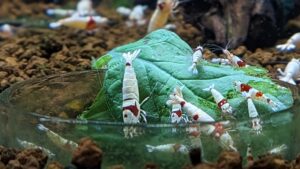Whether you’re a seasoned aquarist or just dipping your toes into the shrimp-keeping world, choosing the right Caridina and Neocaridina shrimp can be a confusing challenge. But don’t worry, we’ve got your back. Let’s break it down and separate top tier shrimp from the posers.
First Things First: What’s Your Endgame?
Before you start throwing money at every pretty shrimp you see, ask yourself:
- Are you just here for the ‘gram? (No shame, those little guys are photogenic) All you need is some pretty shrimp. Forget about genetics and lineages.
- Or are you ready to dive into the deep end of breeding a colony or creating the next big thing?
Your answer will dictate everything that follows.
Genetics: It’s What’s Inside That Counts
Listen up, because this is crucial: GENOTYPE OVER PHENOTYPE, always. Yeah, that metallic boa might look awesome in your tank, but if its genetics are trash, you’re setting yourself up for disappointment.
Here’s a pro tip: If you’re on a budget, you’re better off buying a low-grade shrimp from an award-winning lineage than a high-grade random mutation from some rando’s backyard breeding operation. Trust me on this one. Lineage and genetics are the cornerstone for any breeding project.
Bloodlines: Not Just for Fancy Dogs
When it comes to serious breeding, bloodlines are everything. A shrimp with a solid pedigree has the potential for greatness in their DNA.
Don’t get hypnotized by pretty colors or patterns. Dig deeper. Ask breeders about their shrimps’ lineage. If they start sweating or changing the subject, that’s your cue to peace out.
The Colony Tells All
Want to know if a breeder is legit? Want to know if what they told you about the lineage is legit? Ask to see their entire breeding tank. A high-grade ratio in the colony is a huge green flag.
And while you’re there, hit them with the tough questions:
- What’s the trait inheritance ratio?
- How many of the offspring will actually express the trait I’m after?
- How many of the offspring will be top grade?
If they can’t give you straight answers, it might be time to swipe left on that breeder.

100% OE Inheritance and many berried females
Consistency is Key
When you’re checking out a colony, look for consistent patterns. If the trait you’re after is scarce, that’s a red flag. That means it was likely a random mutation, and not a genetically stable trait. Consistency shows genetic strength, which means a higher chance of your future shrimplets inheriting those sweet traits.
Also check for the color consistency of the colony. You’ll want to find a colony with consistent, thick and opaque color coverage.

Otherwise, this breeder’s just trying to sell off their lucky “high grades” with poor DNA.
Awards: More Than Just Shiny Trophies
International awards aren’t just shiny trophies for breeders to flex on Instagram. They’re the ultimate seal of approval in the shrimp world, and here’s why you should care:
- World-Class Judging: These competitions bring together the crème de la crème of shrimp experts from around the globe. They’re not just looking at pretty colors; they’re assessing every single factor we’ve talked about in this guide.
- Consistency is King: Here’s the kicker – breeders don’t just submit one “perfect” shrimp. They’re required to enter sets of shrimp. The judges are looking for consistency across the entire set. Why? Because consistency is the ultimate proof of genetic stability.
- Genetic Stability = The Holy Grail: Remember when we said genotype matters more than phenotype? This is where it all comes together. A breeder who can produce a consistent set of high-quality shrimp isn’t just lucky; they’ve got their genetics on lock. And that, my friends, is what you want in your tank.
- Comprehensive Evaluation: These judges aren’t messing around. They’re checking for:
- Color intensity and uniformity
- Pattern consistency
- Body shape and size
- Overall health and vitality
- Shrimp behavior
- And yes, even the stuff you can’t see (like the potential for maintaining these traits in future generations)
- Proof in the Pudding: An award-winning breeder has essentially had their entire breeding program validated by the best in the business. It’s like getting a Michelin star, but for shrimp.

Pro Tip: Don’t just take their word for it. Ask to see certificates or proof of their awards. A legit breeder will be more than happy to show off their accolades. If they start making excuses, well… you know the drill.
An international award isn’t just a badge of honor – it’s a testament to the breeder’s skill, the quality of their shrimp, and most importantly, the stability of their genetics. In the world of shrimp breeding, that’s the trifecta you’re looking for.
Shrimp Behavior
Healthy shrimp are like that one friend who can’t sit still – always on the move, foraging, and just looking busy. When you prod them in the tank, they should scatter, but they should recover quickly and get back to their shrimpy business.
Here’s what to look out for:
- Active foraging
- Quick responses to stimuli
- Molting (finding empty shells is a good sign)
- Berried females (ladies carrying eggs = healthy colony)
If the shrimp look lethargic or are constantly hiding, something’s off. Trust your gut on this one.
Breeder’s Shrimp Room: CSI Aquarium Edition
If you get the chance to visit a breeder’s shrimp room (and seriously, try to), here’s what to keep an eye out for:
- Algae Game Strong: Thick green algae on the tank walls isn’t just aesthetic, it’s a buffet for baby shrimp. If the walls are covered with tiny shrimplets, you’ve hit the jackpot.

- Hazy Tanks: Don’t freak out if some tanks look a bit cloudy. As long as there aren’t dead shrimp floating around, it’s all good. That haze could mean the tank is blooming with beneficial bacteria and microbes – basically an all-you-can-eat shrimp restaurant.
- The Nose Knows: If you catch a whiff of something funky, don’t run away just yet. A slight stench from bacteria-rich tanks is normal. But if it smells like death and there are shrimp corpses, that’s your cue to exit.
- Empty Haze: An empty, hazy tank might just be a new setup in the cycling process. No red flags here.

- Overall Vibe: A good breeder’s room should feel like a well-oiled machine. Clean, organized, with healthy-looking shrimp in all tanks.
Final Words of Wisdom
- A cull from a quality colony > a “top grade” from a mediocre setup. Always.
- Health matters. Look for active shrimp that aren’t just lying around like they’ve had too much algae beer.
- If it sounds too good to be true, it probably is. Be skeptical of crazy claims.
- Do your homework on typical prices. Knowledge is power, and in this case, it’ll save you from getting ripped off.
Remember: in the world of shrimp, it’s what’s on the inside that counts. Strong genetics will serve you way better in the long run than a pretty face (or shell, in this case).










